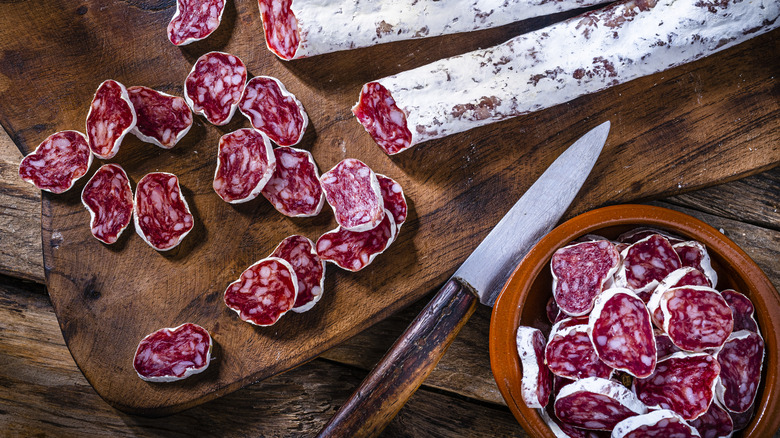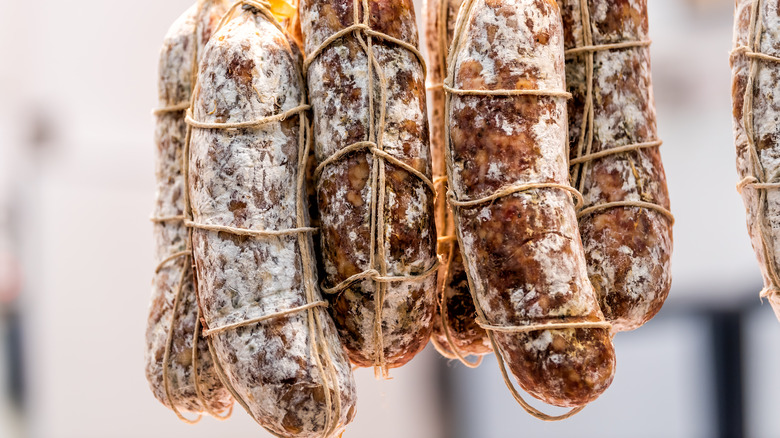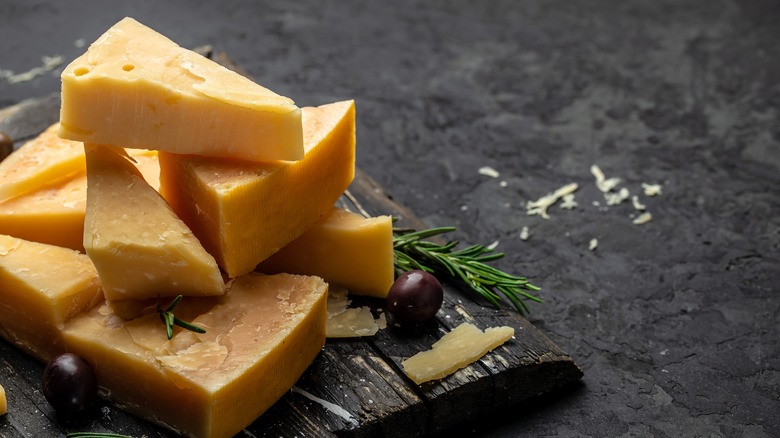How To Identify If The Mold On Your Cured Meat Is Actually Safe To Eat
Common wisdom dictates that if your food is moldy, it's gone bad and you need to throw it away, right? Well, actually, no, not always. Sure, sometimes mold is extremely bad and will make you sick, but there are a few foods that are quite literally based around mold, including certain varieties of cheese (hello, delicious, pungent blues with their signature hue!).
Mold is thus an essential part of the development process for certain foods, like cured meat. While you don't want to eat cold cuts with mold on them, dry-cured meats like salami are supposed to have certain, specific types of mold on them as part of the development process. It's there for a reason, and there's no need to treat it like a parasite. While mold isn't necessarily a bad thing for cured meats, they can still get moldy in a bad way. So how do you tell the difference between safe mold and what we'd call "the bad kind?" It all comes down to what it looks like.
When it comes to mold, it's all about the color
As long as you know what to look for, it's surprisingly not hard to tell when mold on cured meat is a bad thing versus when it's intended. Most cured meats have a thin, white, powdery substance coating their outside. This is actually mold, but it's not something to be worried about: It's actually intended as part of the curing process. It's also perfectly safe to eat, and technically might even be healthy; it's closely related to penicillin, so unless you have an allergy to that family of medications, you're in the clear. (Green mold can also be perfectly fine and is, in some cases, also related to penicillin.)
The molds to avoid are the other colors. Black mold (as in all things) is extremely bad — get rid of that stuff right away. Likewise, yellow, orange, or red molds (otherwise known as Aspergillus flavus, a mycotoxin that typically strikes crops but can show up on cured meats), must be excised immediately. The reason? It can cause aspergillosis, a fungal disease. Depending on the type of aspergillosis, the Centers for Disease Control notes that symptoms can range from a reduced sense of smell to coughing up blood. Really, the color of the mold tells you everything you need to know — not only to avoid dangerous types of mold but to recognize "good" mold, too.
Even if mold isn't good, some foods are still fine as long as you remove it
Even if a food isn't intended to be moldy, apparent mold growth doesn't always necessitate throwing it in the garbage bin. In reality, a number of foods with mold are still safe to eat if you take the proper precautions (and, of course, depending on the specific food in question).
In general, the rule has to do with porousness: Per the USDA, if the food in question is more porous, it's less likely to be salvageable. This is because mold penetrates deep into porous foods; in "harder" foods, however, it's harder for mold to spread beneath the food's surface. This is why you can easily scrape the mold off of a hard cheese like cheddar and still eat it, but you definitely shouldn't do the same with a soft cheese like brie. Likewise, hard vegetables like carrots or radishes are fine to scrape off and eat, but you should never do the same with tomatoes or cucumbers. Bread, a more porous food, is right out — don't even bother trying, just chuck it in the trash.
Like other types of fungus, mold is often misunderstood when it comes to culinary applications. Like most other things in food preparation, it just comes down to knowing what you're dealing with — and when a supposedly scary thing like mold is actually a really good thing.


